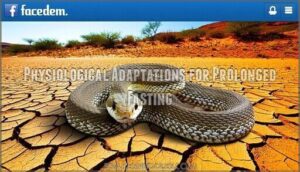This site is supported by our readers. We may earn a commission, at no cost to you, if you purchase through links.
 You’ll find that snakes can survive remarkably long periods without food—ranging from several weeks to over a year depending on the species, size, and environmental conditions.
You’ll find that snakes can survive remarkably long periods without food—ranging from several weeks to over a year depending on the species, size, and environmental conditions.
Large pythons might fast for 6-12 months during breeding season, while smaller species like garter snakes typically need food every 2-4 weeks.
Your snake’s age, health, and metabolic rate all influence how long it can go without eating.
Adult snakes handle fasting much better than juveniles, who require frequent meals for proper growth and development.
Understanding these natural fasting abilities helps distinguish between normal behavior and concerning feeding refusal that requires intervention.
Table Of Contents
- Key Takeaways
- Factors Affecting Snake Fasting Periods
- How Long Can a Snake Go Without Eating
- Snake Feeding Habits and Schedules
- Physiological Adaptations for Prolonged Fasting
- Signs of Hunger and Starvation in Snakes
- Health Risks Associated With Prolonged Snake Fasting
- Recognizing Emergency Situations in Non-eating Snakes
- Strategies to Encourage Feeding in Reluctant Snakes
- Medical Causes of Prolonged Fasting in Snakes
- Veterinary Intervention for Non-eating Snakes
- Frequently Asked Questions (FAQs)
- How long can a snake go without eating?
- How long can a Python Go without eating?
- How often do snakes eat?
- Can a pet snake go without eating?
- What happens to a snake when it doesn’t eat?
- How long can a rat snake live without eating?
- What happens when snakes starve?
- What happens if a snake doesn’t eat for a long time?
- How long can a snake go without food?
- Why do snakes not eat for extended periods?
- Conclusion
Key Takeaways
- Fasting duration depends on your snake’s species and size – larger pythons can survive 6-12 months without food, while smaller species like garter snakes typically need meals every 2-4 weeks
- Age dramatically affects feeding requirements – juvenile snakes need food every 5-7 days for proper growth, but adults can safely fast for months due to slower metabolism
- Natural fasting periods are normal behavior – your snake may refuse food during shedding, breeding season, or winter brumation without causing health concerns
- Monitor for warning signs of dangerous starvation – visible ribs, sunken eyes, weight loss exceeding 10%, and lethargy lasting beyond normal species limits require immediate veterinary attention
Factors Affecting Snake Fasting Periods
Understanding what affects your snake’s fasting ability helps you differentiate between normal behavior and potential health concerns.
Several key factors determine how long your serpent companion can safely go without a meal, from their species-specific metabolism to environmental conditions in their habitat.
Snake Type and Size
The snake species and body size you’re dealing with fundamentally determine fasting limits.
Larger species like pythons possess extensive fat reserves, enabling months-long fasts, while smaller snake types such as garter snakes require frequent feeding due to higher metabolic rates.
Your snake’s energy needs directly correlate with size—bigger bodies mean greater starvation limits but slower metabolism.
Snake Age
Your snake’s age acts like a biological clock, determining how often it needs to fuel up. Young snakes are like teenagers with fast metabolisms – they’re growing rapidly and burning energy quickly. Hatchling Care requires feeding every 5-7 days since their Snake Growth demands constant nutrition. Juvenile Feeding frequencies remain high through their first year.
As the Aging Process unfolds, adult snakes develop slower metabolisms and can handle longer gaps between meals. Senior Health considerations become important as elderly snakes may eat less frequently due to reduced activity levels.
Snake age directly impacts snake metabolism, affecting snake survival without food periods and overall snake feeding habits. Understanding these age-related changes helps prevent snake starvation.
- Growth phase determines feeding frequency: Hatchlings need weekly meals while adults can fast for months
Breeding Time
During breeding season, snakes naturally reduce feeding to concentrate energy on mating rituals.
This temporary snake fasting isn’t cause for concern—it’s evolutionary programming at work.
Both males and females may refuse food weeks before breeding begins, continuing through egg laying and the incubation period.
Their snake metabolism slows deliberately, redirecting resources toward reproduction rather than digestion.
Post-breeding care further extends this fasting period.
If you’re breeding snakes, expect reduced appetites lasting several months.
This snake feeding pattern demonstrates their remarkable ability to prioritize survival of the species over individual nutrition.
Shedding
When your snake approaches ecdysis process, you’ll notice their appetite disappears completely.
Snake shedding typically occurs every 4-8 weeks depending on age and growth rate. During this period, snake metabolism slows as energy redirects toward skin regeneration.
Humidity importance becomes critical—inadequate moisture causes shedding problems that extend fasting periods.
Snake behavior shifts dramatically; they become less active and refuse food entirely. This snake fasting phase lasts 1-2 weeks, with snake appetite returning once the old skin sheds completely.
Time of Year
Seasonal changes dramatically impact your snake’s feeding behavior.
During winter, brumation slows their metabolism to near-hibernation levels, often eliminating appetite for months.
Temperature drops trigger this natural response, while warmer seasons restore normal seasonal appetite patterns.
Environmental factors like daylight and temperature impact regulate these cycles, with some species fasting throughout hibernation length periods of 3-5 months before resuming regular feeding schedules.
How Long Can a Snake Go Without Eating

You’re probably wondering how long your pet snake can safely skip meals, especially if it’s been refusing food lately.
The answer varies dramatically based on species, size, and environmental conditions, with some snakes surviving weeks while others can endure months or even years without eating.
Average Fasting Periods for Pet Snakes
Understanding your pet snake’s fasting timeline isn’t just about numbers—it’s about recognizing Species Differences and Age Influence on their unique snake eating habits.
Captivity Effects create predictable Feeding Schedules unlike wild counterparts.
Your snake’s snake feeding frequency depends on size, age, and season. During brumation, extended fasting becomes natural behavior.
However, juveniles face serious Health Impact after just 2-3 weeks without food, while robust adults can comfortably skip meals for months.
Pet snake feeding varies dramatically:
- Ball pythons: Adults fast 2-6 months safely, juveniles need weekly meals
- Corn snakes: Adults manage 1-2 months, hatchlings require 5-7 day intervals
- Smaller species: Garter snakes typically last 2-3 months maximum
Monitor your snake’s snake diet patterns—consistent refusal outside normal cycles warrants veterinary attention.
Fasting Periods for Wild Snakes
Wild environments present extreme challenges where wild snakes face unpredictable Natural Prey Scarcity.
Wild Snake Metabolism adapts dramatically during these periods, with species like ball pythons surviving six months during dry seasons through Brumation Effects.
Seasonal Food Availability varies drastically – reticulated pythons endure seven-month fasts when prey disappears.
Habitat Impact determines starvation tolerance, as environmental factors force metabolism reductions up to seventy-two percent for snake survival without food.
Factors Influencing Fasting Duration
Several key factors determine how long your snake can safely fast, creating a complex web of biological and environmental influences.
Species Differences play the primary role—larger constrictors like ball pythons naturally fast for months, while smaller species such as garter snakes require more frequent meals.
Age Influence affects metabolism substantially, with juveniles needing food every 1-2 weeks compared to adults who can wait months.
Consider these critical factors affecting fasting duration:
- Temperature – Cold conditions slow snake metabolism dramatically
- Breeding Season – Reproductive cycles often trigger natural fasting periods
- Shedding Impact – Snakes typically refuse food during skin renewal
- Environmental Conditions – Stress, humidity, and habitat quality matter
- Snake Size – Larger individuals store more energy reserves
- Health Status – Illness shortens safe fasting periods considerably
Understanding these environmental factors helps you recognize whether your snake’s fasting represents normal behavior or requires intervention.
Snake Feeding Habits and Schedules
Understanding your snake’s natural feeding patterns and environmental needs is essential for proper care.
Wild snakes hunt based on prey availability, while pet snakes thrive on consistent schedules that match their species-specific requirements and seasonal behaviors.
Natural Prey Availability in The Wild
In the wild, prey abundance fluctuates dramatically with seasonal variation and habitat impact.
You’ll find snake species adapting their hunting success rates to match prey diversity availability.
During abundant periods, snakes capitalize on multiple feeding opportunities.
Lean seasons force strategic energy conservation, directly affecting snake feeding behavior and extending periods when snakes survive without regular meals.
Controlled Feeding Schedules for Pet Snakes
Your pet snake needs Feeding Frequency that matches its species—corn snakes typically eat weekly, while ball pythons can wait two weeks.
Juveniles require more frequent meals than adults.
Diet Variety matters; rotate between appropriately-sized frozen-thawed rodents.
Prey Size should match your snake’s thickest body section.
During brumation, expect reduced appetite—that’s perfectly normal seasonal behavior for proper snake care tips.
Impact of Environmental Factors on Feeding
Environmental temperature acts as your snake’s metabolic thermostat, dramatically influencing feeding behavior. When conditions aren’t ideal, even the hungriest serpent might refuse its next meal.
Temperature effects directly impact snake metabolism – too cold slows digestion, while excessive heat creates stress. Humidity influence affects hydration levels, with dry conditions reducing appetite.
Seasonal changes trigger natural fasting periods, especially during winter months. Brumation impact causes extended feeding refusal as snakes enter dormancy. Environmental conditions including lighting, substrate, and enclosure size create stress factors that suppress feeding responses.
- Temperature fluctuations outside species-specific ranges disrupt normal feeding schedules
- Low humidity causes dehydration, making snakes reluctant to eat
- Seasonal transitions naturally decrease appetite as metabolism adjusts
- Habitat disruptions from cage changes or handling create temporary feeding strikes
- Brumation periods can last months with complete feeding cessation
Physiological Adaptations for Prolonged Fasting
You’ll discover that snakes possess remarkable physiological mechanisms that allow them to survive extended periods without food, far exceeding what most animals can endure.
These evolutionary adaptations include dramatic metabolic slowdowns, strategic energy storage systems, and cellular-level changes that basically put their bodies into survival mode during prolonged fasting, which involve remarkable physiological mechanisms.
Metabolic Rate Reduction Mechanisms
When you’re wondering how snakes survive extended fasting periods, metabolic suppression becomes their superpower.
Your snake’s body dramatically reduces its metabolic rate by up to 72%, creating an impressive metabolic slowdown that minimizes energy expenditure.
This energy conservation strategy involves organ prioritization, where non-essential systems dial down while critical functions continue.
Hormonal regulation triggers cellular autophagy, recycling cellular components for fuel.
During starvation, snake metabolism shifts into survival mode, with oxygen consumption dropping substantially.
This remarkable adaptation allows snakes to weather food shortages that would challenge other animals.
Energy Storage in Fat Reserves
Your snake’s fat reserves serve as its biological fuel tank during extended fasting periods.
These lipid reserves concentrate in the abdomen and around organs, providing energy efficiency that’s nothing short of remarkable.
Through fat metabolism, snakes can maintain essential functions for months, transforming stored energy into glucose.
This fasting adaptation allows snake survival without food by meeting snake energy needs when prey becomes scarce, showcasing nature’s incredible starvation resilience.
Organ Shrinkage During Starvation
While fat reserves provide initial energy, your snake’s body takes conservation even further through organ shrinkage during starvation.
This remarkable adaptation involves cellular autophagy—where cells literally consume themselves to survive. Reduced functionality becomes the new normal as tissue degradation occurs systematically.
The extreme fasting of diets like Snake Diet can cause such effects.
- Heart and liver shrink up to 40% during extended fasting periods
- Reversibility limits exist—prolonged starvation causes permanent organ damage
- Survival impact varies based on species and pre-starvation health status
Protein Conservation Strategies
Biochemical warfare unfolds within starving snakes as they employ sophisticated amino acid recycling mechanisms.
You’ll witness remarkable muscle protein breakdown reduction—up to 70%—while nitrogen excretion reduction conserves precious resources.
Enzyme activity modulation shifts snake metabolism from protein catabolism to lipid oxidation, dramatically lowering energy expenditure during starvation periods.
Signs of Hunger and Starvation in Snakes
You’ll need to recognize when your snake shifts from natural fasting to concerning starvation through specific physical and behavioral indicators.
Understanding these warning signs helps you distinguish between normal appetite cycles and potential health emergencies that require immediate attention.
Increased Activity and Tongue Flicking
When your snake transforms into a restless explorer, hunting behavior intensifies through sensory perception mechanisms.
Frequent tongue flicking samples environmental cues for chemical traces, while increased movement signals active prey-seeking mode.
These stress signals indicate your snake’s metabolic rates are driving foraging instincts, demonstrating how snake survival without food triggers behavioral changes before visible snake starvation symptoms appear during extended snake fasting duration periods.
Weight Loss and Body Condition Changes
Beyond the obvious behavioral cues, visible weight loss serves as your most reliable indicator of snake starvation.
You’ll notice body mass declining as skeletal changes become apparent along the spine.
Muscle atrophy develops gradually, while organ shrinkage occurs internally as your snake’s metabolic rate slows.
These weight loss indicators signal depleted fat reserves, making regular snake body condition monitoring essential for preventing dangerous snake starvation scenarios.
Behavioral Changes and Aggression
Beyond physical deterioration, hungry snakes exhibit distinct behavioral shifts that signal their nutritional distress.
You’ll observe these key aggression triggers when snake starvation occurs:
- Heightened defensive posture – Even docile species adopt attack modes more readily
- Increased snake temper – Normal handling tolerance decreases substantially
- Feeding frenzy behaviors – Striking at non-food items becomes common
These snake behavioral changes stem from snake stress and snake appetite loss, creating a survival-focused mindset where snake refusal to eat paradoxically increases aggression.
Visible Skeletal Structure and Sunken Eyes
When starvation signs become visible, your snake’s skeletal visibility and sunken eyes signal serious malnutrition effects.
Weight loss progresses to where spine ridges protrude noticeably, while eye sinking creates hollow appearances around the orbital sockets.
These lethargy-accompanied symptoms indicate your snake’s survival without food has reached dangerous limits, requiring immediate veterinary intervention to prevent irreversible damage.
Health Risks Associated With Prolonged Snake Fasting
While snakes can survive extended fasting periods, prolonged starvation poses serious health threats that you need to recognize.
Extended periods without food compromise your snake’s immune system, damage essential organs, cause muscle deterioration, and disrupt reproductive functions.
Weakened Immune System
Prolonged starvation severely compromises your snake’s immune system, making it vulnerable to infections and diseases.
Starvation weakens your snake’s defenses, leaving it exposed to dangerous infections and diseases
Research shows fasting reduces immune cells by over 90%, creating dangerous health risks. This reduction is similar to the effects of prolonged fasting on the immune system.
Three critical immune system impacts include:
- Dramatic white blood cell reduction – Monocytes and lymphocytes migrate from bloodstream to bone marrow
- Increased infection susceptibility – Weakened defenses allow bacterial and parasitic diseases to flourish
- Impaired wound healing – Compromised inflammatory responses slow recovery from injuries
Organ Damage and Failure
Extended starvation triggers severe organ damage in your snake’s body.
The liver experiences impaired detoxification processes, leading to liver damage and cellular degeneration.
Kidney failure becomes likely as waste elimination systems break down.
Heart problems develop from weakened cardiac muscle, while tissue necrosis spreads throughout essential organs, creating life-threatening conditions requiring immediate veterinary intervention.
Muscle Wasting and Mobility Issues
Muscle atrophy becomes a devastating reality when your snake faces prolonged starvation.
Snake metabolism slows dramatically, but the body still requires energy, forcing it to cannibalize muscle tissue for survival. This muscle degeneration severely compromises your snake’s mobility and hunting ability, creating a dangerous downward spiral.
Watch for these critical starvation effects:
- Muscle tone loss: Visible weakness in coiling and movement
- Mobility loss: Difficulty traversing terrain or climbing
- Snake paralysis: Severe cases affecting basic locomotion.
Snake nutritional needs must be met to prevent irreversible muscle damage and restore proper snake energy expenditure.
Reproductive Problems and Infertility
Looking beyond mobility concerns, snake starvation severely impacts reproduction through hormone imbalance and reproductive disorders.
You’ll notice breeding issues when malnourished females can’t produce quality eggs or experience egg binding. Males show reduced fertility and decreased mating behavior.
Snake reproductive problems stem from nutritional deficiencies that disrupt normal hormone cycles. Infertility causes include inadequate fat reserves needed for egg development and sperm production.
Snake health issues compound when breeding season coincides with prolonged fasting periods, creating lasting reproductive consequences.
Recognizing Emergency Situations in Non-eating Snakes
You’ll need to distinguish between normal fasting behaviors and dangerous feeding refusal that requires immediate attention.
While healthy adult snakes can safely fast for weeks or months depending on their species, certain warning signs indicate when a non-eating snake has crossed into emergency territory.
Normal Fasting Periods Vs. Problematic Refusal
Most snakes naturally fast during feeding cycles, especially during shedding or seasonal changes. However, refusal signs become concerning when fasting durations exceed normal survival limits.
Watch for these critical indicators:
- Snake starvation symptoms like visible spine ridges
- Weight loss exceeding 10% of body mass
- Lethargy combined with snake refusal to eat
- Sunken eyes or wrinkled skin texture
- Starvation period lasting beyond species-specific timeframes
Snakes often experience post shed appetite issues, which can be addressed by understanding the snake not eating behaviors and adjusting their environment accordingly.
Juvenile Snake Feeding Requirements
Young snakes can’t handle extended fasting like adults—they’re growing machines that need consistent fuel.
Hatchling care demands attention to snake feeding requirements since snake juvenile starvation periods are much shorter than mature specimens.
Key Snake Growth Feeding Schedules:
- Frequency: Feed hatchlings every 5-7 days (adults wait 10-14 days)
- Snake Nutritional Requirements: Offer prey 10-15% of body weight for ideal development
- Young Snake Diet Monitoring: Watch for rapid weight loss after just 2-3 weeks without food
Nutrient needs skyrocket during development phases.
Adult Snake Feeding Frequency
Adult snakes follow predictable feeding schedules based on their species and size.
You’ll find most adults eat every 1-2 weeks, with larger species requiring less frequent meals due to slower snake metabolism.
| Species | Feeding Interval | Prey Size | Survival Period | Notes |
|---|---|---|---|---|
| Ball Python | 10-14 days | Medium rodent | 6+ months | Notorious fasters |
| Corn Snake | 7-10 days | Small rodent | 1-2 weeks | Consistent feeders |
| Boa Constrictor | 14 days | Large rodent | 6+ months | Seasonal variations |
| King Snake | 7-14 days | Medium rodent | 2-3 months | Active hunters |
| Western Hognose | 7 days | Small rodent | 1-3 months | Drama queens |
Understanding normal adult nutrition patterns helps you recognize when feeding habits signal trouble versus natural fasting cycles.
Signs of Severe Malnutrition
Recognizing severe malnutrition in your snake requires watching for critical warning signs that signal immediate intervention. Weight loss, dehydration risks, and starvation effects become dangerously apparent when nutritional deficiencies progress unchecked.
Key malnutrition signs include:
- Visible spine and ribs protruding through loose, wrinkled skin
- Sunken eyes and lethargy indicating severe dehydration and organ failure
- Dramatic weight loss exceeding 15-20% of normal body mass
Strategies to Encourage Feeding in Reluctant Snakes
When your snake refuses meals, you can often trigger their feeding response through targeted adjustments to prey presentation and environmental conditions.
Strategic modifications to prey size, feeding techniques, temperature, and habitat conditions frequently resolve feeding strikes within days to weeks.
Adjusting Prey Size and Type
When your snake turns up its nose at dinner, prey selection becomes your secret weapon.
The wrong prey size can trigger feeding refusal—too large creates stress, too small fails to satisfy their snake metabolism.
Prey variation often solves stubborn feeding problems, as many species respond positively to different textures, scents, or temperatures.
Food quality substantially impacts prey consumption patterns.
Fresh, appropriately-sized prey typically generates stronger feeding responses than stale options.
Your snake’s digestive system processes different prey types at varying rates, affecting their feeding schedule.
Understanding the importance of proper snake food options reptile nutrition needs is vital for maintaining a healthy snake.
| Prey Type | Feeding Response | Best For |
|---|---|---|
| Frozen-thawed | Consistent, safe | Most species |
| Live prey | High stimulation | Reluctant feeders |
| Pre-killed fresh | Natural scent | Picky eaters |
Experiment with feeding techniques—some snakes prefer darkness, others respond to movement simulation.
Snake nutrition improves when you match prey to natural preferences.
Remember, snake survival without food varies by species, but proper prey selection prevents unnecessary fasting periods.
Modifying Feeding Environment and Techniques
Beyond adjusting prey size, modifying your snake’s feeding environment often stimulates their appetite.
Environmental controls like temperature adjustments and proper lighting create ideal conditions. Food presentation techniques using feeding trays and feeding tools can make prey more appealing.
Consider these approaches:
- Adjust snake enclosures lighting and heating to match natural feeding patterns
- Vary food presentation angles and locations within the habitat
- Use feeding trays to create designated feeding zones that reduce stress.
Effective snake care involves using proper snake feeding techniques to promote healthy eating habits.
Addressing Potential Stressors
Environmental stressors can sabotage your snake’s appetite faster than you’d think.
Stress Management starts with identifying culprits: excessive Snake Handling, poor lighting, or vibrations from nearby electronics.
Environmental Control means maintaining consistent temperatures and eliminating sudden noises.
Habitat Optimization includes providing adequate hiding spots and minimizing disturbances.
These snake stress factors directly influence feeding aversion, so create a sanctuary where your serpent feels secure and ready to eat.
Proper Temperature and Humidity Maintenance
After addressing stressors that might be keeping your snake from eating, you’ll want to focus on climate management. Temperature control and humidity levels directly impact snake metabolism and digestive system function.
Creating proper thermal gradients helps your snake feel secure enough to feed again. Environmental monitoring becomes your best friend here.
Use digital thermometers to maintain species-specific temperatures—most snakes need basking spots around 85-95°F. Snake survival without food often relates to poor climate conditions that shut down their appetite.
- Temperature zones: Establish warm and cool areas for thermoregulation
- Humidity maintenance: Monitor levels between 50-60% for most species
- Consistent monitoring: Check conditions daily using reliable gauges
Effective temperature management involves using a temperature controller to regulate the environment.
Medical Causes of Prolonged Fasting in Snakes
When your snake refuses food for extended periods, underlying medical conditions often cause the problem.
Respiratory infections, parasitic infestations, digestive disorders, and neurological issues can all trigger prolonged fasting behavior that requires veterinary attention.
Respiratory Infections and Mouth Rot
Among top-tier ailments disrupting your snake’s appetite, respiratory disease and mouth rot rank as leading culprits.
These bacterial infections create painful mouth lesions and breathing difficulties that make feeding impossible. Proper snake hygiene and infection control prevent these issues, while respiratory care addresses existing problems.
You’ll notice open-mouth breathing, oral discharge, and tissue swelling. Bacterial treatment requires veterinary antibiotics—don’t delay seeking professional help when respiratory issues emerge, as untreated cases worsen rapidly.
Understanding the common causes is essential for preventing mouth rot in snakes.
Parasitic Infestations
Parasite infestations can turn your snake’s feeding routine upside down, causing prolonged fasting that mimics serious illness.
Internal parasites like intestinal worms disrupt the snake digestive system, while external parasites such as snake mites create constant irritation.
Common parasite-related feeding issues include:
- Intestinal parasites reducing nutrient absorption and appetite
- Snake mites causing stress and behavioral changes
- Tick infestations weakening overall snake health through blood loss
Proper parasite diagnosis and parasite control restore normal snake nutrition patterns.
Digestive System Disorders
Through the intricate pathways of your snake’s digestive tract, various disorders can transform mealtime into misery. Gastrointestinal Issues range from Intestinal Blockage caused by oversized prey to inflammatory conditions that disrupt normal gut function.
When your serpent’s snake digestive system malfunctions, feeding becomes painful and appetite vanishes completely. Digestive Enzymes may become insufficient, preventing proper nutrient breakdown.
Inflammatory Disease can attack intestinal walls, while impacted substrate creates dangerous obstructions. These conditions substantially impact snake metabolism and can lead to severe snake nutritional deficiencies.
| Disorder | Primary Symptoms |
|---|---|
| Impaction | Swollen abdomen, lethargy |
| Gastritis | Regurgitation, appetite loss |
| Enteritis | Diarrhea, dehydration |
| Obstruction | Visible swelling, pain responses |
Snake starvation studies show that compromised Gut Health accelerates decline during fasting periods. Early veterinary intervention prevents minor digestive issues from becoming life-threatening emergencies.
Neurological Issues Affecting Feeding Behavior
If digestive system disorders aren’t the culprit, neurological issues often disrupt snake feeding behavior.
Brain damage, nerve disorders, and neurotoxin effects can hijack snake appetite control and feeding reflexes. You’ll notice odd behaviors and sensory issues that throw off their routine.
Snake starvation studies show how metabolic rates plummet under these conditions. Watch for:
- Sudden seizures or tremors
- Uncoordinated movements
- Loss of feeding reflex
- Unusual sensory responses
Veterinary Intervention for Non-eating Snakes
Knowing when your snake needs professional veterinary care can mean the difference between a minor issue and a life-threatening emergency.
Reptile veterinarians use specialized diagnostic tools and techniques to identify underlying health problems that cause feeding refusal in snakes.
When to Seek Professional Help
When your snake’s feeding problems persist beyond normal fasting periods, Emergency Care becomes necessary.
If you notice Starvation Symptoms like visible ribs, sunken eyes, or lethargy lasting weeks, don’t wait—Medical Intervention can prevent Snake Malnutrition from becoming life-threatening.
Vet Guidance helps distinguish between natural snake appetite control and serious snake illness.
Professional snake veterinary care guarantees your pet’s snake survival without food doesn’t cross dangerous thresholds, providing peace of mind when home remedies aren’t cutting it.
Diagnostic Procedures for Fasting Snakes
When your snake refuses food persistently, your veterinarian will conduct thorough diagnostic procedures to identify underlying causes.
Professional evaluation helps distinguish normal fasting behaviors from serious health conditions requiring immediate intervention.
- Blood Tests and Fecal Analysis – Laboratory work reveals infections, parasitic infestations, and metabolic disorders affecting snake survival without food and normal snake fasting patterns.
- Ultrasound Scans and X-ray Imaging – These visualization techniques detect internal masses, impactions, and organ abnormalities disrupting snake digestive efficiency and metabolism.
- Snake Endoscopy and Biopsy Analysis – Advanced procedures examine internal tissues directly, identifying specific pathologies causing prolonged snake starvation periods.
Understanding uric acid levels is vital for accurate diagnosis of renal diseases in snakes.
Frequently Asked Questions (FAQs)
How long can a snake go without eating?
You’ll find most snakes can survive weeks to months without food, depending on their species and size.
Larger pythons endure up to two years, while smaller species like corn snakes last just weeks.
How long can a Python Go without eating?
Ever wondered how these powerful constrictors master the art of patience?
You’ll be amazed that pythons can survive six months to over a year without food, with some reticulated pythons documented fasting for twelve to eighteen months in captivity.
How often do snakes eat?
Feeding schedules vary dramatically between species, with your pet python eating every 10-14 days while your garter snake needs weekly meals. Juveniles require more frequent feeding than adults.
Can a pet snake go without eating?
Yes, your pet snake can absolutely go without eating for extended periods.
Most species survive weeks to months without food naturally – ball pythons can fast 6+ months, while smaller species like corn snakes handle 1-2 weeks comfortably.
What happens to a snake when it doesn’t eat?
When your snake stops eating, you’ll notice gradual weight loss as it burns stored fat reserves. Its metabolism slows dramatically, potentially dropping 70% to conserve energy during fasting periods.
How long can a rat snake live without eating?
Remarkably, rat snakes can survive at least six months without food by dramatically reducing their metabolic rate.
You’ll find these resilient serpents can endure extended fasting periods through impressive physiological adaptations.
What happens when snakes starve?
When you watch a starving snake, you’ll notice dramatic metabolic changes as its body desperately conserves energy.
The reptile reduces its metabolic rate by up to 70%, basically entering survival mode while organs begin failing from prolonged malnutrition.
What happens if a snake doesn’t eat for a long time?
Approximately 70% of snake species can reduce their metabolic rate by up to 72% during starvation.
When you don’t feed your snake for extended periods, it’ll experience weight loss, organ failure, and potentially death if the fast continues beyond species-specific limits.
How long can a snake go without food?
You’ll find most snakes can survive weeks to months without food, depending on their species and size.
Larger pythons might fast for over a year, while smaller species like garter snakes typically last only two to three months before requiring sustenance, and this duration can vary greatly depending on the species.
Why do snakes not eat for extended periods?
Snakes can reduce their metabolic rates by up to 72% during starvation periods.
You’ll find they stop eating due to natural biological cycles like brumation, shedding phases, breeding seasons, stress responses, or environmental temperature changes that trigger their survival adaptations.
Conclusion
Knowledge is power regarding understanding how long a snake can go without eating.
You’ve learned that fasting periods vary dramatically—from weeks for smaller species to over a year for large pythons.
Your snake’s species, age, and health status directly influence its fasting tolerance.
Remember that juveniles need frequent feeding while adults handle extended fasts naturally.
Monitor your snake’s body condition, behavior, and feeding responses carefully.
When normal fasting becomes concerning refusal, don’t hesitate to consult an experienced reptile veterinarian for proper assessment and intervention, considering the snake’s overall health status and feeding responses.
- https://www.sciencedirect.com/science/article/pii/B9780123864543007867
- https://sites.pitt.edu/~mcs2/herp/SoNA.html
- https://www.livescience.com/7348-snakes-survive-months-food.html
- https://www.sciencedaily.com/releases/2007/08/070824173005.htm
- https://www.newscientist.com/article/2360963-fasting-for-24-hours-could-weaken-the-immune-system/




















